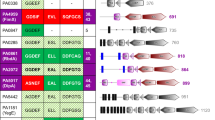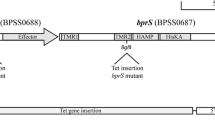Abstract
Burkholderia sp. is a gram-negative bacterium that commonly exists in the environment, and can cause diseases in plants, animals, and humans. Here, a transposon mutant library of a Burkholderia lata isolate from a pig with swine respiratory disease in Korea was screened for strains showing attenuated virulence in Caenorhabditis elegans. One such mutant was obtained, and the Tn5 insertion junction was mapped to rpfR, a gene encoding a cyclic di-GMP phosphodiesterase that functions as a receptor. Mutation of rpfR caused a reduction in growth on CPG agar and swimming motility as well as a rough colony morphology on Congo red agar. TLC analysis showed reduced AHL secretion, which was in agreement with the results from plate-based and bioluminescence assays. The mutant strain produced significantly more biofilm detected by crystal violet staining than the parent strain. SEM of the mutant strain clearly showed that the overproduced biofilm contained a filamentous structure. These results suggest that the cyclic di-GMP phosphodiesterase RpfR plays an important role in quorum sensing modulation of the bacterial virulence and biofilm formation.
Similar content being viewed by others
References
Asad, S. and Opal, S.M. 2008. Bench-to-bedside review: Quorum sensing and the role of cell-to-cell communication during invasive bacterial infection. Crit. Care 12, 236.
Bassis, C.M. and Visick, K.L. 2010. The cyclic-di-GMP phosphodiesterase BinA negatively regulates cellulose-containing biofilms in Vibrio fischeri. J. Bacteriol. 192, 1269–1278.
Bassler, B.L., Wright, M., and Silverman, M.R. 1994. Multiple signalling systems controlling expression of luminescence in Vibrio harveyi: sequence and function of genes encoding a second sensory pathway. Mol. Microbiol. 13, 273–286.
Bi, H., Christensen, Q.H., Feng, Y., Wang, H., and Cronan, J.E. 2012. The Burkholderia cenocepacia BDSF quorum sensing fatty acid is synthesized by a bifunctional crotonase homologue having both dehydratase and thioesterase activities. Mol. Microbiol. 83, 840–855.
Boon, C., Deng, Y., Wang, L.H., He, Y., Xu, J.L., Fan, Y., Pan, S.Q., and Zhang, L.H. 2008. A novel DSF-like signal from Burkholderia cenocepacia interferes with Candida albicans morphological transition. ISME J 2, 27–36.
Chankhamhaengdecha, S., Hongvijit, S., Srichaisupakit, A., Charnchai, P., and Panbangred, W. 2013. Endophytic actinomycetes: a novel source of potential acyl homoserine lactone degrading enzymes. Biomed. Res. Int. 2013, 782847.
Coenye, T. 2010. Social interactions in the Burkholderia cepacia complex: biofilms and quorum sensing. Future Microbiol. 5, 1087–1099.
Coenye, T. and Vandamme, P. 2003. Diversity and significance of Burkholderia species occupying diverse ecological niches. Environ. Microbiol. 5, 719–729.
Deng, Y., Boon, C., Eberl, L., and Zhang, L.H. 2009. Differential modulation of Burkholderia cenocepacia virulence and energy metabolism by the quorum-sensing signal BDSF and its synthase. J. Bacteriol. 191, 7270–7278.
Deng, Y., Lim, A., Wang, J., Zhou, T., Chen, S., Lee, J., Dong, Y.H., and Zhang, L.H. 2013. Cis-2-dodecenoic acid quorum sensing system modulates N-acyl homoserine lactone production through RpfR and cyclic di-GMP turnover in Burkholderia cenocepacia. BMC Microbiol. 13, 148.
Deng, Y., Schmid, N., Wang, C., Wang, J., Pessi, G., Wu, D., Lee, J., Aguilar, C., Ahrens, C.H., Chang, C., et al. 2012. Cis-2-dodecenoic acid receptor RpfR links quorum-sensing signal perception with regulation of virulence through cyclic dimeric guanosine monophosphate turnover. Proc. Natl. Acad. Sci. USA 109, 15479–15484.
Deng, Y., Wu, J., Eberl, L., and Zhang, L.H. 2010. Structural and functional characterization of diffusible signal factor family quorum-sensing signals produced by members of the Burkholderia cepacia complex. Appl. Environ. Microbiol. 76, 4675–4683.
Deng, Y., Wu, J., Tao, F., and Zhang, L.H. 2011. Listening to a new language: DSF-based quorum sensing in Gram-negative bacteria. Chem. Rev. 111, 160–173.
Eberl, L. 2006. Quorum sensing in the genus Burkholderia. Int. J. Med. Microbiol. 296, 103–110.
Friedman, L. and Kolter, R. 2004. Two genetic loci produce distinct carbohydrate-rich structural components of the Pseudomonas aeruginosa biofilm matrix. J. Bacteriol. 186, 4457–4465.
Garcia, B., Latasa, C., Solano, C., Garcia-del Portillo, F., Gamazo, C., and Lasa, I. 2004. Role of the GGDEF protein family in Salmonella cellulose biosynthesis and biofilm formation. Mol. Microbiol. 54, 264–277.
Hickman, J.W., Tifrea, D.F., and Harwood, C.S. 2005. A chemosensory system that regulates biofilm formation through modulation of cyclic diguanylate levels. Proc. Natl. Acad. Sci. USA 102, 14422–14427.
Karki, H.S., Barphagha, I.K., and Ham, J.H. 2012. A conserved twocomponent regulatory system, PidS/PidR, globally regulates pigmentation and virulence-related phenotypes of Burkholderia glumae. Mol. Plant Pathol. 13, 785–794.
Khanna, N., Cressman III, C.P., Tatara, C.P., and Williams, P.L. 1997. Tolerance of the nematode Caenorhabditis elegans to pH, salinity, and hardness in aquatic media. Arch. Environ. Contam. Toxicol. 32, 110–114.
Kim, S.K. and Lee, J.H. 2016. Biofilm dispersion in Pseudomonas aeruginosa. J. Microbiol. 54, 71–85.
Kirillina, O., Fetherston, J.D., Bobrov, A.G., Abney, J., and Perry, R.D. 2004. HmsP, a putative phosphodiesterase, and HmsT, a putative diguanylate cyclase, control Hms-dependent biofilm formation in Yersinia pestis. Mol. Microbiol. 54, 75–88.
Kuchma, S.L., Brothers, K.M., Merritt, J.H., Liberati, N.T., Ausubel, F.M., and O’Toole, G.A. 2007. BifA, a cyclic-di-GMP phosphodiesterase, inversely regulates biofilm formation and swarming motility by Pseudomonas aeruginosa PA14. J. Bacteriol. 189, 8165–8178.
Larsen, R.A., Wilson, M.M., Guss, A.M., and Metcalf, W.W. 2002. Genetic analysis of pigment biosynthesis in Xanthobacter autotrophicus Py2 using a new, highly efficient transposon mutagenesis system that is functional in a wide variety of bacteria. Arch. Microbiol. 178, 193–201.
Lee, H.S., Gu, F., Ching, S.M., Lam, Y., and Chua, K.L. 2010. CdpA is a Burkholderia pseudomallei cyclic di-GMP phosphodiesterase involved in autoaggregation, flagellum synthesis, motility, biofilm formation, cell invasion, and cytotoxicity. Infect. Immun. 78, 1832–1840.
Lee, Y., Lee, Y., Lim, S., Park, G., Choi, S., Hong, H., and Ko, J. 2013. Volatile compounds and ultrastructure of petal epidermal cells according to scent intensity in Rosa hybrida. Korean J. Hortic. Sci. Technol. 31, 590–597.
Mahenthiralingam, E., Urban, T.A., and Goldberg, J.B. 2005. The multifarious, multireplicon Burkholderia cepacia complex. Nat. Rev. Microbiol. 3, 144–156.
Marchler-Bauer, A., Derbyshire, M.K., Gonzales, N.R., Lu, S., Chitsaz, F., Geer, L.Y., Geer, R.C., He, J., Gwadz, M., Hurwitz, D.I., et al. 2015. CDD: NCBI’s conserved domain database. Nucleic. Acids. Res. 43, D222–D226.
McClean, K.H., Winson, M.K., Fish, L., Taylor, A., Chhabra, S.R., Camara, M., Daykin, M., Lamb, J.H., Swift, S., Bycroft, B.W., et al. 1997. Quorum sensing and Chromobacterium violaceum: exploitation of violacein production and inhibition for the detection of N-acylhomoserine lactones. Microbiology 143, 3703–3711.
Mil-Homens, D., Rocha, E.P., and Fialho, A.M. 2010. Genome-wide analysis of DNA repeats in Burkholderia cenocepacia J2315 identifies a novel adhesin-like gene unique to epidemic-associated strains of the ET-12 lineage. Microbiology 156, 1084–1096.
Molina, L., Constantinescu, F., Michel, L., Reimmann, C., Duffy, B., and Defago, G. 2003. Degradation of pathogen quorum-sensing molecules by soil bacteria: a preventive and curative biological control mechanism. FEMS Microbiol. Ecol. 45, 71–81.
Ryan, R.P., McCarthy, Y., Watt, S.A., Niehaus, K., and Dow, J.M. 2009. Intraspecies signaling involving the diffusible signal factor BDSF (cis-2-dodecenoic acid) influences virulence in Burkholderia cenocepacia. J. Bacteriol. 191, 5013–5019.
Schmid, N., Pessi, G., Deng, Y., Aguilar, C., Carlier, A.L., Grunau, A., Omasits, U., Zhang, L.H., Ahrens, C.H., and Eberl, L. 2012. The AHL-and BDSF-dependent quorum sensing systems control specific and overlapping sets of genes in Burkholderia cenocepacia H111. PLoS One 7, e49966.
Schmid, N., Suppiger, A., Steiner, E., Pessi, G., Kaever, V., Fazli, M., Tolker-Nielsen, T., Jenal, U., and Eberl, L. 2017. High intracellular c-di-GMP levels antagonize quorum sensing and virulence gene expression in Burkholderia cenocepacia H111. Microbiology 163, 754–764.
Shaw, P.D., Ping, G., Daly, S.L., Cha, C., Cronan, J.E., Jr., Rinehart, K.L., and Farrand, S.K. 1997. Detecting and characterizing Nacyl-homoserine lactone signal molecules by thin-layer chromatography. Proc. Natl. Acad. Sci. USA 94, 6036–6041.
Simm, R., Morr, M., Kader, A., Nimtz, M., and Romling, U. 2004. GGDEF and EAL domains inversely regulate cyclic di-GMP levels and transition from sessility to motility. Mol. Microbiol. 53, 1123–1134.
Stanier, R.Y., Palleroni, N.J., and Doudoroff, M. 1966. The aerobic pseudomonads: a taxonomic study. J. Gen. Microbiol. 43, 159–271.
Steindler, L. and Venturi, V. 2007. Detection of quorum-sensing N-acyl homoserine lactone signal molecules by bacterial biosensors. FEMS Microbiol. Lett. 266, 1–9.
Suppiger, A., Aguilar, C., and Eberl, L. 2016a. Evidence for the widespread production of DSF family signal molecules by members of the genus Burkholderia by the aid of novel biosensors. Environ. Microbiol. Rep. 8, 38–44.
Suppiger, A., Eshwar, A.K., Stephan, R., Kaever, V., Eberl, L., and Lehner, A. 2016b. The DSF type quorum sensing signalling system RpfF/R regulates diverse phenotypes in the opportunistic pathogen Cronobacter. Sci. Rep. 6, 18753.
Suppiger, A., Schmid, N., Aguilar, C., Pessi, G., and Eberl, L. 2013. Two quorum sensing systems control biofilm formation and virulence in members of the Burkholderia cepacia complex. Virulence 4, 400–409.
Sutphin, G.L. and Kaeberlein, M. 2009. Measuring Caenorhabditis elegans life span on solid media. J. Vis. Exp. 27, 1152.
Tamayo, R., Pratt, J.T., and Camilli, A. 2007. Roles of cyclic diguanylate in the regulation of bacterial pathogenesis. Annu. Rev. Microbiol. 61, 131–148.
Tedesco, P., Di Schiavi, E., Esposito, F.P., and de Pascale, D. 2016. Evaluation of Burkholderia cepacia complex bacteria pathogenicity using Caenorhabditis elegans. Bio. Protoc. 6, e1964.
Tischler, A.D. and Camilli, A. 2004. Cyclic diguanylate (c-di-GMP) regulates Vibrio cholerae biofilm formation. Mol. Microbiol. 53, 857–869.
Vanlaere, E., Baldwin, A., Gevers, D., Henry, D., De Brandt, E., Li-Puma, J.J., Mahenthiralingam, E., Speert, D.P., Dowson, C., and Vandamme, P. 2009. Taxon K, a complex within the Burkholderia cepacia complex, comprises at least two novel species, Burkholderia contaminans sp. nov. and Burkholderia lata sp. nov. Int. J. Syst. Evol. Microbiol. 59, 102–111.
Venturi, V., Friscina, A., Bertani, I., Devescovi, G., and Aguilar, C. 2004. Quorum sensing in the Burkholderia cepacia complex. Res. Microbiol. 155, 238–244.
Author information
Authors and Affiliations
Corresponding author
Rights and permissions
About this article
Cite this article
Jung, HI., Kim, YJ., Lee, YJ. et al. Mutation of the cyclic di-GMP phosphodiesterase gene in Burkholderia lata SK875 attenuates virulence and enhances biofilm formation. J Microbiol. 55, 800–808 (2017). https://doi.org/10.1007/s12275-017-7374-7
Received:
Revised:
Accepted:
Published:
Issue Date:
DOI: https://doi.org/10.1007/s12275-017-7374-7




